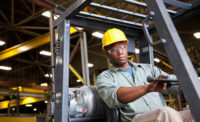Compressed air is integral in nearly every industry, from powering tools and providing pressure for robotic assembly arms to inflating tires and even cleaning off dusty surfaces.
Companies might offer training on how to use compressed air and its related tools, but does any of this include how to use them safely? Why should companies offer compressed air safety training, and what negative repercussions could they face for not providing it?
1. Compressed air is dangerous
While compressed air can be used to power nearly any tool from impact hammers to grinders and even robotic arms, it can be dangerous or even deadly if misused. Most devices require between 50 and 90 psi — pounds per square inch — of pressure to function.
When this pressure comes into contact with flesh, it can break the skin, damage organs and force air bubbles into the bloodstream. A tiny quantity of air in the blood can be fatal, causing an embolism. Air blown into the mouth can rupture the lungs or other organs.
Embolisms caused by compressed air misuse are rare, but they are possible.
Cleaning with compressed air, especially high-pressure systems that are designed to power tools, can create hazards as well. It takes very little pressure to accelerate sawdust or metal shavings to hundreds of feet per second, creating a shrapnel hazard.
Compressed air should never be directed at the human body, regardless of the psi of the system. According to OSHA regulations, air pressure that comes into contact with the skin has to be at less than 30 psi, but that isn't always the safest option.
2. Compressed air can be expensive
Compressed air training should include everything from safety and how to avoid misuse to proper use and maintenance. Every employee in the facility, regardless of their responsibilities, should be trained in the use and maintenance of this equipment.
Even with high-efficiency modern systems, compressed air is expensive to generate. Roughly half of all compressed air generated is wasted, and the majority of this waste is the direct result of a lack of education. Providing comprehensive training for all employees can help reduce this waste, which in turn will lower costs and improve productivity.
Comprehensive training will also help prevent misuse and improve workplace safety. If the crew knows how to use the equipment properly — and there are procedures in place for things like cleaning — they will be less likely to use the material dangerously.
3. Negative repercussions
What negative repercussions can a company face if it chooses not to offer compressed air safety training? While there are no statistics that list the number of compressed air-related accidents around the world, the fact remains that more than 4 million workers are injured on the job every year in the United States alone. Globally, there are more than 2.2 million work-related fatalities annually.
One problem that is often overlooked is the risk of whiplash when dealing with compressed air systems. If a pressurized hose fractures, it releases a massive amount of pressure that can injure or kill anyone who gets in its way.
Proper training on use and maintenance can prevent these injuries. Everyone on the production floor should know how to use compressed air tools, how to inspect the equipment to ensure it is in working order and how to shut off the compressed air to prevent injuries.
A company that doesn't spend time training its team members can expect to lose money on workers' compensation claims from employee injuries or fatalities. Downtime after an accident, while the event is being investigated, will also be costly. If a company produces $50 worth of product every minute during normal operations, a single hour of downtime can cost the company more than $10,000.
Wrapping it up
Compressed air safety training isn't optional. If compressed air is being used in a production facility, every team member should be trained in its use, safe practices and proper maintenance. Any observed misuse should be swiftly corrected because it can be incredibly dangerous.
About 90 psi of compressed air, the standard power needed for most compressed air tools, can be harmful or even deadly when directed at the human body. This is one area where businesses cannot afford to cut corners.




